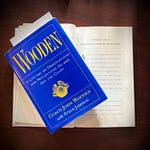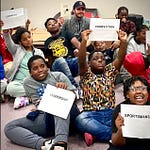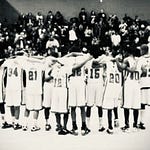There is a strong chance you spent time today thinking about your dream, that which you yearn to create or experience in your life. There’s a stronger chance you are unaware of the resistance that is keeping you from it. I’ll ask you some leading questions:
What is this creation or experience you are thinking of right now?
What is this dream that seems too far away, too complicated, or too foreign?
What is keeping you from it?
Write down your immediate answers. Express it. Freewrite until your mind clears some of the weeds on its own. By the end of this blog and podcast, you’ll realize the athlete within you already knows how to overcome resistance.
I’ll begin with the importance of blank canvases in the battle versus resistance. This piece, itself—what you are reading or listening to—is an exercise in my personal journey in overcoming internal resistance. It is a version of my blank canvas.
For me, writing a book was an immense lesson in resistance. Becoming an author was a goal upon graduating from college. I realized the theme of my upcoming book - the values and education of sport - about fifteen years ago. I decided the title, Endless Teachable Moments - roughly eight years ago. Six years ago, I finally built the courage to find and follow through on my voice, a voice more motivated to create art over information. In between all of that was an unknown enemy named resistance. I didn’t know any writers. I knew nothing of the process. I knew a lot of athletes, coaches, leaders, and teachers. The blueprint for writing a book was difficult to find.
I was often told I should write a book. Many friendly voices told me my words had meaning and influence. There were other less inspirational voices though. They were voices of resistance and were far more prevalent than the voices of encouragement. And to think, the voices of resistance don’t come from actual people. They came from inside me. They were voices of doubt.
That word: resistance. Get to know it. It’s already there, lurking in the bushes, revealing itself at your most vulnerable moments. Resistance is an internal voice that creates subtle, fear-based obstacles in our path of creativity and personal growth. Resistance is doubt in disguise. It whispers to you: You can’t. Now is not the right time. Don’t begin until you are ready, you know, when life is a little less complicated. What if it doesn’t work? What if you aren’t good enough? What if they don’t like it?
Resistance never tells you who the they are that might not like it, the thing you have yet to create. Resistance keeps us from beginning or completing the thing. If undetected, resistance may, without us even knowing it, keep us from the experience altogether.
I learned three key lessons through my internal battle against the incredible power of resistance: 1) I truly had no idea what resistance actually was nor the power it holds in one’s life, 2) a rather stealth enemy resistance has turned out to be, and 3) perfectionism, excessive planning, order, an obsession with the outcome, and staying within the perceived established rules of art were all forms of friendly fire. I was fighting myself, creating self-inflicted delays, and waiting for the moment in which all was right in my world - waiting, impatiently, for the impossible.
Resistance feeds and grows from an abundance of timing, process, and order. The fictitious rules of process and order hindered me from the habits necessary to create, or rather, complete good art. One could call this unintentional excuse-making for slow or no progress, but excuses they are nonetheless. It’s important to own our part in the problem. As athletes, we are taught, hopefully, to take complete ownership over our failures. This was not a failure of outcome, it was a failure to begin. But also, as athletes, we know what it takes to overcome resistance. We’ve already done it.
Rules though, they feel safe don’t they? Rules create a sense of security. My resistant mind would tell me, there must be a blueprint for creating great work. There must be a system that works for the great writer and artist, or coach and teacher. There must be a program, a guide, a way in which things are done. I must spend time researching such rules. What did the greats do? What a supremely ridiculous question. Even asking that question attaches us to the outcome before we even begin, and outcome-oriented thinking is a recipe for igniting the fire of resistance. But, like many of you, I felt I was only worthy or credible if I follow their rules, the greats and their path, step by step. Each orderly preference only aided the resistance within me and was certain to make it less likely I’d finish the final product. And ironically, in all my research, I’ve never found the actual rules.
Acclaimed, bestselling author, Neil Gaiman, famously spoke of such rules, why they should be ignored or never known, and the importance of making good art so that is simply exists in reality. His commencement address to the University of the Arts on May 17th, 2012 was a lifeline to the artist and creator within me. I viewed it on Youtube in 2016. I’ve viewed it on average once a month since. He inspired me to disregard the rules, find my voice, make mistakes, and make good art, no matter what was happening in my life. Neil may have never coached a sport, but he became the coach I needed. I then found a notebook, some old scribbles of the past, and began writing. I wrote and I wrote, poem after poem, essay after essay, thought after thought. I wrote just to write. I even finished some poems along the way. I encourage you to listen to Gaiman’s address, for both the content and his remarkable delivery.
I am an orderly person. Thanks to Stephen Covey and the 7 Habits of Highly Effective People — a tremendous professional guide mind you — I begin with the end in mind, habit number two in his book. I am a coach and an educator. I prefer to determine the goal and plan backwards from it. It’s a natural practice for the educator. I enjoy creating a strategic plan. I prefer to know when I’m on target and when I am not. This works well for me in many professional sectors. I am very comfortable there. But in my journey as a writer, one that was attempting to infuse sport and art, the order of things became the main obstacle. Order was a cobweb I could not free myself from, nor did I realize I was stuck in it. Ironically, I never experienced this beast as a young athlete. I practiced on my own and used my imagination. I went outside and played. I attended team practices and games and would then go back outside and play more. Play itself is a blank canvas. I often ponder why we let go of such brilliant themes as adults.
A dear friend recommended the book, The War of Art, by Steven Pressfield. The title, a play on words for The Art of War by Sun Tzu. Steven gave me a name and a face for the wildly powerful enemy in the bushes: resistance. Prior to that, I mistook resistance and the invisible air of doubt for life circumstances that were not fitting for productivity. I knew I had a passion for writing but I didn’t feel the time was right to fully immerse. At work, however, give me an important project with a two-day deadline and I’ll wrap a bow on it in two to four hours. And it will be good work. No resistant voices there. For any creator of anything that is dear to your heart, I give The War of Art my highest recommendation. It was profoundly revealing.
It’s okay for us to believe in blueprints and study them. It is okay to have a plan. But what I can tell you is art and expression must start with a first stroke on a first blank canvas. The end result will either work or it won’t work, but you’ll certainly experience growth. I’m not here to give you the rules or guidelines for joining me on this blog and podcast journey. I’m not here to create an exact outline of things to come. I’m here to practice courage, failure, and growth. I’m here to experience the blank canvas. The great 19th century American writer, Ralph Waldo Emerson, has never stopped reminding us, “Do not go where the path may lead; go instead where there is no path and leave a trail.”
In the beginning of our journey with sport, we simply just began. We played. We went outside and we played. We weren’t good. We weren’t skilled. But we played and imagined and created and visualized and dreamed and then played some more. We built games out of games. Every day was a draft, a blank canvas in development. Eventually, we learned a new skill or concept. We grew with each mistake. We learned from losses and wins, successes and failures. And we most likely had some fun in the process.
But dare I give fair warning in my older age, sport—especially for our youth—has now fed the beast of resistance without even realizing it. More than ever, we are creating the habit of resistance at younger and younger ages. Very simply: the beast of resistance is fed from the programming and over programming of athletes. Athletes, young and old, are learning to only operate well if they are programmed, scheduled, told what to do and how to do it without having any time and space dedicated to figuring it out for themselves. There is now an ocean of resources for athletes, but not enough sand to play in before getting to water. There are so many advisors and videos and workout programs and gurus that it nearly requires another advisor just to guide us toward what is quality and what is not. Parents are overwhelmed. But are our our kids playing? Are they going outside to hit rocks with a wiffleball bat, kicking the ball against a concrete wall, or playing touch football with the neighbors? Sport, like creativity and art, requires a blank canvas - free play, practice, open gyms, open fields, sandlots, concrete courts, and time and space to create free of distraction, time and space for imagination and immersion. And this goes for athletes of all ages. Less programming and more space. Send the children outside and let them figure it out. Send yourself outside to figure it out. Create space for imagination. Empower the athletes by giving them blank canvases. Coaches, create space for player-led scenarios in practice and in the off-season. Sure, give athletes some boundaries, drills, good practice sessions, and core values, but also provide them a ball, a space, ample time, and the least amount of adult voices interfering. You’ll be amazed at what athletes can do when they are empowered to create.
This blog and podcast is my blank canvas. I’m taking what I learned playing wiffleball with friends. I’m taking what I learned in all of the imaginary basketball leagues and seasons and “10 seconds to go in the game” scenarios. I’m winging it, intentionally, just as I did when I would gather the kids in the neighborhood for a game of you name it. It’s my power over resistance. But I am winging it with years of experience, a fairly interesting life journey, and a converging bit of wisdom in the realm of art, education, community, and culture within sport.
This wisdom tells me to begin. Just begin. Do not overthink. Relinquish any thought on the outcome. Get out the blank canvas and paint. Make it exist in reality.
Your first painting or book or poem will be just fine, but rarely as good as your last. Your first practice in a new sport will be just fine. The first team you coach will be just fine. The first class you teach will be just fine. Your first mile on the trail you always dreamt of walking will be just fine.
Or maybe it won’t, and that is okay.
But I assure you, the next one will most likely be a bit better. The journey of growth will make all the difference.
Just begin. Go outside and play.
Be great & break barriers,
Jason Aron Ronai













